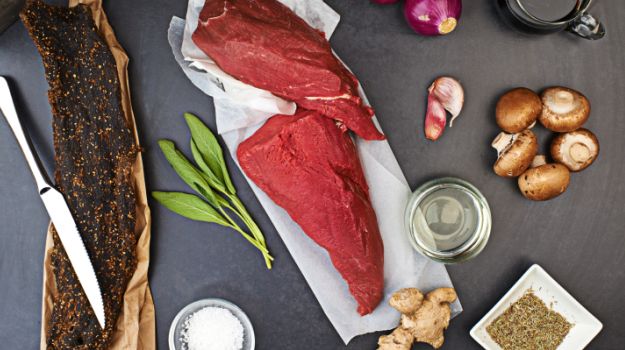Stone Age Diets Could Have Included Rotten Meat as a Common Food Item

In 1907, British explorer Arnold Henry Savage Landor wrote in his book about travel in Africa of witnessing an impromptu meal that his companions enjoyed but he found unimaginably revolting.
The group was coasting down a river in the Congo Basin when a dead rodent floated near their canoe. The decomposing body had bloated to the size of a small pig, causing a stench that left Landor gasping for breath. He tried to signal his companions to steer the canoe away from the fetid creature, but they hauled the rodent aboard and ate it.
“The odor when they dug their knives into it was enough to kill the strongest of men,” Landor wrote. “When I recovered, my admiration for the digestive powers of these people was intense. They were smacking their lips and they said the [rodent] had provided most excellent eating.”
European and American explorers, traders, government officials, missionaries, and others who lived among Indigenous peoples in many parts of the world wrote of similar food practices. Hunter-gatherers and small-scale farmers everywhere commonly ate putrid meat, fish, and fatty parts of a wide range of animals, either raw, fermented, or cooked just enough to singe off fur and create a more chewable texture. Many groups considered maggots as a meaty bonus.
Some Indigenous communities feasted on huge decomposing beasts, including hippos that had been trapped in dug-out pits in Africa and beached whales on Australia’s coast. Hunters in those groups typically smeared themselves with the fat of the animal before gorging on greasy innards. After slicing open animals’ midsections, both adults and children climbed into massive, rotting body cavities to remove meat and fat. Native Americans in Missouri during the late 1800s made a prized soup from the greenish, decaying flesh of dead bison. Animal bodies were buried whole in winter and unearthed in spring after ripening enough to achieve peak tastiness.
Such accounts provide a valuable window into a way of life that existed long before Western industrialization and the war against germs went global, says anthropological archaeologist John Speth of the University of Michigan in Ann Arbor. Intriguingly, no reports of botulism and other potentially fatal reactions to microorganisms festering in rotting meat appear in writings about Indigenous groups before the early 1900s. Instead, decayed flesh and fat represented valued and tasty parts of a healthy diet.
This dietary revelation also challenges an influential scientific idea that cooking originated among our ancient relatives as a way to make meat more digestible, thus providing a rich calorie source for brain growth in the Homo genus. It’s possible, Speth argues, that Stone Age hominids such as Neandertals first used cooking for certain plants that provided an energy-boosting carbohydrate punch to the diet. Animals held packets of fat and protein that, after decay set in, rounded out nutritional needs without needing to be heated.
Speth’s curiosity about a human taste for putrid meat was originally piqued by present-day hunter-gatherers in polar regions. North American Inuit, Siberians, and other far-north populations still regularly eat fermented or rotten meat and fish. Chukchi herders in the Russian Far East, for instance, bury whole fish in the ground in early fall and let the bodies naturally ferment during periods of freezing and thawing. Fish heads the consistency of hard ice cream are then unearthed and eaten whole.
\nSpeth has believed for years that Indigenous Northern groups have a long history of eating fermented and putrid meat, fish, fat, and internal organs. He found many ethnohistorical descriptions of this behavior dating back to the 1500s by mainly consulting online sources such as Google Scholar and universities' digital library catalogs. Speth reported much of this evidence in 2017 in PaleoAnthropology. In temperate and tropical areas, where animal bodies decompose within hours or days, Indigenous peoples have also appreciated rot. Speth and anthropological archaeologist Eugène Morin of Trent University in Peterborough, Canada, described some of these obscure ethnohistorical accounts last October in PaleoAnthropology. Speth says that these accounts undermine some of scientists' food-related beliefs. For example, European explorers and other travelers consistently wrote that traditional groups not only ate putrid meat raw or lightly cooked but also suffered no ill after-effects. A protective gut microbiome may explain why, Speth said. Indigenous peoples encountered various microorganisms from infancy, unlike people today who grow up in sanitized settings. Early exposure to pathogens may have prompted the development of an array of gut microbes and immune responses that protected against potential harms of ingesting putrid meat. This idea requires further investigation, but studies conducted over the last few decades indicate that putrefaction, the process of decay, offers many of cooking's nutritional benefits with far less effort. Putrefaction pre-digests meat and fish, softening the flesh and chemically breaking down proteins and fats so they are more easily absorbed and converted to energy by the body. According to Speth, given the ethnohistorical evidence, hominids living 3 million years ago or more could have scavenged meat from decomposing carcasses and eaten them raw without fearing any consequences, long before fire was used for cooking. Researchers suspect the regular use of fire for cooking, light, and warmth emerged no earlier than about 400,000 years ago. Jessica Thompson of Yale University says, "Recognizing that eating rotten meat is possible, even without fire, highlights how easy it would have been to incorporate scavenged food into the diet long before our ancestors learned to hunt or process [meat] with stone tools." Thompson and colleagues suggested in Current Anthropology in 2019 that before about 2 million years ago, hominids were primarily scavengers who used rocks to smash open animal bones and eat nutritious, fat-rich marrow and brains. Untangling whether ancient hominids truly had a taste for rot will require research in many fields, including microbiology, genetics, and food science.\n
According to a new study by archaeologist John Speth, ancient cooks may not have been turning out meat dishes after all. Instead, Speth speculates that cooking's primary value lay in making starchy and oily plants softer, more chewable, and easily digestible. Edible plants contain carbohydrates and sugar molecules that can be converted to energy in the body. Heating over a fire converts starch in tubers and other plants to glucose, a vital energy source for the body and brain. Crushing or grinding of plants might have yielded at least some of those energy benefits to hungry hominids who lacked the ability to light fires.
It is unknown whether hominids controlled fire well enough to cook plants or any other food regularly prior to around 400,000 to 300,000 years ago. Despite their nutritional benefits, plants often get viewed as secondary menu items for Stone Age folks. This is due in part to the fact that plants preserve poorly at archaeological sites. Neandertals, in particular, have a long-standing reputation as plant shunners. Popular opinion views Neandertals as burly, shaggy individuals who huddled around fires chomping on mammoth steaks.
Elevated levels of a diet-related form of nitrogen in Neandertal bones and teeth hint that they were committed carnivores, eating large amounts of protein-rich lean meat. However, consuming that much protein from meat, especially from cuts above the front and hind limbs now referred to as steaks, would have been a recipe for nutritional disaster. Meat from wild, hoofed animals and smaller creatures such as rabbits contains almost no fat or marbling, unlike meat from modern domestic animals. Ethnohistorical accounts, especially for northern hunters including the Inuit, include warnings about weight loss, ill health and even death that can result from eating too much lean meat.
This form of malnutrition is known as rabbit starvation. Evidence indicates that people can safely consume between about 25 and 35 percent of daily calories as protein. Above that threshold, several investigations have indicated that the liver becomes unable to break down chemical wastes from ingested proteins, which then accumulate in the blood and contribute to rabbit starvation. Limits to the amount of daily protein that can be safely consumed meant that ancient hunting groups, like those today, needed animal fats and carbohydrates from plants to fulfill daily calorie and other nutritional needs.
Modern "Paleo diets" emphasize eating lean meats, fruits, and vegetables. But that omits what past and present Indigenous peoples most wanted from animal carcasses. Accounts describe Inuit people eating much larger amounts of fatty body parts than lean meat. Over the last few centuries, they have favored tongue, fat deposits, brisket, ribs, fatty tissue around intestines and internal organs, and marrow. Internal organs, especially adrenal glands, have provided vitamin C — nearly absent in lean muscle — that prevented anemia and other symptoms of scurvy.
Western explorers noted that the Inuit also ate chyme, the stomach contents of reindeer and other plant-eating animals. Chyme provided at least a side course of plant carbohydrates. Likewise, Neandertals in Ice Age Europe probably subsisted on a fat- and chyme-supplemented diet. Large numbers of animal bones found at northern European Neandertal sites may instead reflect overhunting of animals to obtain enough fat to meet daily calorie needs. Because wild game typically has a small percentage of body fat, northern hunting groups today and over the last few centuries frequently killed prey in large numbers, either discarding most lean meat from carcasses or feeding it to their dogs.
If Neandertals followed that playbook, eating putrid foods might explain why their bones carry a carnivore-like nitrogen signature. An unpublished study of decomposing human bodies kept at a University of Tennessee research facility in Knoxville called the Body Farm tested that possibility. Biological anthropologist Melanie Beasley, now at Purdue University in West Lafayette, Ind., found moderately elevated tissue nitrogen levels in 10 deceased bodies sampled regularly for about six months. Tissue from those bodies served as a stand-in for animal meat consumed by Neandertals. Human flesh is an imperfect substitute for, say, reindeer, or elephant carcasses. But Beasley's findings suggest that decomposition's effects on a range of animals need to be studied. Intriguingly, she also found that maggots in the decaying tissue displayed extremely elevated nitrogen levels.
According to Speth, Neandertals may have consumed putrid meat and fish contaminated with maggots, much like arctic hunters did centuries ago. Elevated levels of nitrogen in Neandertal fossils can be explained by this practice.
However, there is a lack of understanding about Neandertal dining habits. A recent analysis of fossil remains from the Neumark-Nord site in northern Germany, which is approximately 125,000 years old, has provided unusual evidence of Neandertal consumption from big-game hunting. Archaeologist Sabine Gaudzinski-Windheuser from Johannes Gutenberg University in Germany and colleagues analyzed patterns of stone-tool incisions on bones of at least 57 elephants from 27 spots near an ancient lake basin where Neandertals lit campfires and constructed shelters. The evidence suggests that Neandertal butchers removed fat deposits under the skin and fatty body parts such as internal organs, tongue, brain, and feet's thick layers of fat, much like Inuit hunters. The researchers argue that lean meat was eaten in small amounts to avoid rabbit starvation.
Further research is required to discover if the Neandertals cooked elephant meat or boiled the bones to extract nutritious grease. According to Speth, the availability of cooking techniques opened up options for hominids who could not only consume putrid meat and fat but also heat animal parts over fires. Neandertals who hunted elephants must have also eaten a variety of plants to meet their significant energy requirements. However, only fragments of burned hazelnuts, acorns, and blackthorn plums have been discovered at Neumark-Nord so far, according to Gaudzinski-Windheuser.
Neandertals in warm Mediterranean and Middle Eastern settings probably consumed fruit, nuts, and seeds from a variety of plants at a site in coastal Spain, providing better evidence of their plant preferences. According to archaeologist Karen Hardy from the University of Glasgow, Neandertals in a variety of environments must have consumed numerous starchy plants. For example, even Stone Age northern European and Asian regions included plants with starch-rich appendages that grew underground, such as tubers. According to Hardy, Neandertals could also have obtained starchy carbs from the edible, inner bark of many trees and from seaweed along coastlines. Cooking would have greatly increased the nutritional value of plants, as suggested by Speth. Rotten meat and fat would not have provided the same benefits, but Neandertals such as those at Neumark-Nord may have cooked what they gleaned from fresh elephant remains.
According to Hardy, there is direct evidence that Neandertals consumed plants, such as microscopic remnants of edible and medicinal plants found in the tartar on their teeth. In the Journal of Human Evolution published in January 2022, she concludes that carbohydrate-fueled energy helped maintain large brains, enable strenuous physical activity, and ensure healthy pregnancies for both Neandertals and ancient Homo sapiens. However, researchers disagree over whether Neandertals, who lived between 400,000 and 40,000 years ago, were a variant of H. sapiens or a separate species.
Speth believes that plants provided a significant portion of the energy and nutrients required by Stone Age humans, just like Hardy. Plants offered a more predictable and readily available food source than hunted or scavenged meat and fat, he contends. In addition, plants provided Neandertals and ancient H. sapiens, whose diets were probably no different from Neandertals, a chance to stretch their taste buds and cook up tangy meals.
A recent investigation suggests that Paleolithic plant cooking had preplanned steps designed to enhance basic dishes with specific flavors. Charred plant food fragments from Shanidar Cave in Iraqi Kurdistan and Franchthi Cave in Greece consisted of crushed pulse seeds, perhaps derived from starchy pea species, combined with wild plants that would have provided a pungent, somewhat bitter taste, microscopic analyses revealed. Archaeobotanist Ceren Kabukcu from the University of Liverpool in England and colleagues reported last November in Antiquity that added ingredients included wild mustard, wild almonds, wild pistachio, and fruits such as hackberry.
Four Shanidar food bits date to about 40,000 years ago or more and originated in sediment that included stone tools attributed to H. sapiens. Another food fragment, likely from a cooked Neandertal meal, dates to between 70,000 and 75,000 years ago. Neandertal fossils found in Shanidar Cave are also about 70,000 years old. So it appears that Shanidar Neandertals spiced up cooked plant foods before Shanidar H. sapiens did, Kabukcu says.
Franchthi food remains date to between 13,100 and 11,400 years ago, when H. sapiens lived there. Wild pulses in food from both caves display microscopic signs of having been soaked, a way to dilute poisons in seeds and moderate their bitterness.
These new findings “suggest that cuisine, or the combination of different ingredients for pleasure, has a very long history indeed,” says Hardy, who was not part of Kabukcu’s team.
There’s a hefty dollop of irony in the possibility that original Paleo diets mixed what people in many societies today regard as gross-sounding portions of putrid meat and fat with vegetarian dishes that still seem appealing.
Our mission is to provide accurate, engaging news of science to the public. That mission has never been more important than it is today.
As a nonprofit news organization, we cannot do it without you.
Your support enables us to keep our content free and accessible to the next generation of scientists and engineers. Invest in quality science journalism by donating today.




